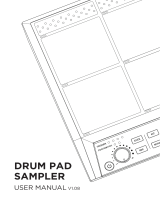
12
Trigger Settings (TRIG)
Adjusting the Drum Trigger’s Minimum
Sensitivity (Threshold)
Here’s how to make settings so that the trigger signal is
detected only when you strike the trigger with a certain
force or greater.
Preventing unwanted triggering from the
environment
In some cases, a drum trigger might respond to live
sound from acoustic drums or to sound from the
monitor speakers. Either raise the drum trigger’s
Threshold value, or make the following changes to
your setup.
5 Move the drum trigger farther away from the
speakers
5 Angle the drum trigger, and set it in a location that
is less aected by the sound
Since the TM-6 PRO is intended for use on stage, the
drum trigger’s Threshold value is set relatively high by
default. If you want to give priority to expression of
soft strikes, lower the Threshold value while staying
above the level at which unwanted triggering occurs.
1. Press the [TRIG] button.
2. Use the cursor buttons to select “PARAM,”
and then press the [ENTER] button.
3. Press the [F1] or [F2] (THRESHOLD/SENS) button.
The TRIGGER THRESHOLD screen appears.
Input type
Threshold
Trigger type
Volume change in
response to strike strength
Sensitivity
4. Select the drum trigger that you want to
edit (p. 11).
5. Use cursor buttons to select “Threshold,”
and use the [–] [+] buttons to adjust the
sensitivity.
Parameter Explanation
Threshold
Increase this value if the drum trigger
is unwantedly triggered by ambient
vibration. If this value is too high, soft
strikes will not produce sound. You should
set this to the lowest value that will not
cause unintended triggering.
In the illustration, ‘B’ will trigger a sound,
but ‘A’ and ‘C’ will not.
Threshold
6. Press the [EXIT] button several times to
return to the KIT screen.
Adjusting the Drum Trigger’s Sensitivity
(Sensitivity)
Here’s how to adjust the drum trigger’s sensitivity to specify
the balance between the force of your strike and the
loudness of the sound.
1. Access the TRIGGER THRESHOLD screen
(p. 12).
2. Select the drum trigger that you want to
edit (p. 11).
3. Use cursor buttons to select “Sensitivity,”
and use the [–] [+] buttons to adjust the
sensitivity.
4. Press the [EXIT] button several times to
return to the KIT screen.
Reference
For details on more advanced drum trigger settings, refer
to “Reference Manual” (PDF).
Making Hi-hat Settings
If you’re using a VH-10 or VH-11 V-hi-hat (subsequently
called a “VH”), adjust the oset on the TM-6 PRO.
This adjustment is required in order to correctly detect
open, close, and pedal operations.
1. After making the hi-hat settings, release
your foot from the pedal, and while keeping
your foot o the pedal, turn on the power of
the TM-6 PRO.
2. Loosen the clutch screw and let the hi-hat
rest naturally on the motion sensor unit.
3. Press the [TRIG] button.
4. Use the cursor buttons to select the “HI-
HAT,” and press the [ENTER] button.
5. While reading the meter displayed on the
right side of the TM-6 PRO’s screen, adjust
the oset with the VH’s oset adjustment
screw.
Adjust the oset so that the appear in the meter.
Amount of how easy to
make the foot splash
(
&
PDF)
6. Press the [EXIT] button several times to
return to the KIT screen.





















